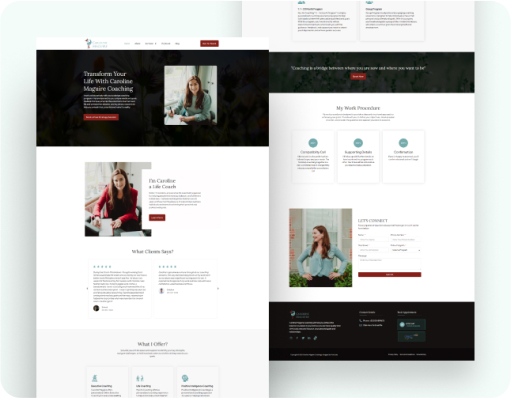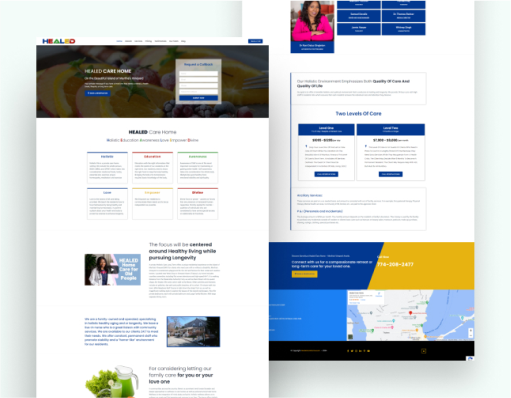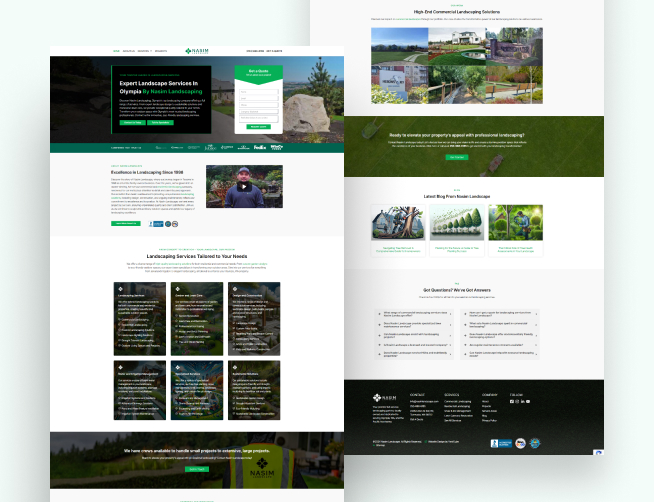Leading Web Design Company in Dhaka: Expertise, Quality, and Affordability
VentCube provides professional web design services that reflect your brand’s identity and captivate your audience. Whether it’s a new site or a redesign, our customized approach ensures your business makes a lasting impact online.
we have worked with 50+ Companies





We are Trusted by Industry Leaders








Steps We Take to Create
Professional Web Designs for Your Business
Understanding Your Vision and Goals
- Deep Brand Discovery:We begin by gaining a deep understanding of your business, brand, and objectives to create a design that authentically represents your vision.
- User Journey Mapping: We map out intuitive user journeys, ensuring that visitors are guided effortlessly toward taking meaningful actions, such as making a purchase or signing up.
- Strategic Blueprint Creation: We develop a design blueprint that outlines the structure and features of your future website.
Designing a User-Friendly Website
- Custom, Visual Design: We create a visually stunning design tailored to your brand’s unique style, ensuring it stands out and leaves a lasting impression.
- Mobile Responsiveness: Your website will be fully responsive, providing an optimal viewing and interaction experience across all devices, from desktops to smartphones.
- Optimized User Experience (UX): We focus on usability, designing seamless navigation and intuitive features that enhance the user journey and keep visitors engaged.
Developing and Optimizing Your Site
- Modern Technology Build: We utilize the latest technologies to develop a fast, secure, and scalable website that can grow with your business..
- Speed and SEO Optimization: Your site will be optimized for fast load times and improved search engine rankings, ensuring both a superior user experience and better visibility online.
- Feature Integration: We seamlessly incorporate key features such as e-commerce, blogs, or booking systems, tailored to meet your business requirements and enhance functionality.
Launching and Supporting Your Website
- Seamless Launch: We oversee the entire launch process, ensuring a smooth and hassle-free transition as your website goes live.
- Ongoing Maintenance: Our team offers continuous support, performing regular updates and improvements to keep your website functioning at its best.
- Security and Performance Monitoring: We actively monitor your website’s security and performance, making regular enhancements to ensure it remains safe, fast, and efficient.
What We Do?
Our services focus on optimizing your website to improve performance, drive higher conversions, and leave a strong impression on your clients. We create tailored solutions that help your business grow online by attracting and engaging visitors effectively.
Custom WordPress Web Development
We specialize in creating custom WordPress websites designed specifically for your target audience. Our development approach focuses on delivering visually engaging, highly functional websites that align with your business objectives and provide an exceptional user experience
UX Design & Wireframing
We prioritize crafting seamless user experiences by creating detailed wireframes and design mockups. Our approach ensures that your website is intuitive, easy to navigate, and optimized to keep users engaged, ultimately boosting conversion rates.
PSD & Figma to WordPress
We expertly transform your PSD or Figma designs into fully functional WordPress websites. Our team ensures that every detail is meticulously aligned, responsive, and optimized for top-notch performance, delivering a seamless user experience across all devices.
E-commerce Solutions
We build powerful e-commerce platforms designed to elevate your online sales. By implementing smart tools and effective strategies, we create intuitive shopping experiences that enhance customer satisfaction and drive revenue growth.
Transforming Businesses Globally: VentCube – Your Premier Web Design & Digital Solutions Partner
VentCube is recognized as a leading web design company delivering cutting-edge digital solutions worldwide. Headquartered in Dhaka, Bangladesh, we are proud to provide top-tier web development services with a strong commitment to quality, innovation, and customer satisfaction.
As a full-service digital agency, VentCube offers customized website packages that include high-performance SSD Linux hosting and domain name registration at competitive prices. Our comprehensive suite of services includes Web Design & Development, E-commerce Website Development, Branding, Search Engine Optimization (SEO), Social Media Marketing & Management, Email Marketing, Google Ads & Digital Advertising
VentCube proudly serves a diverse range of clients from Bangladesh and across the globe, including the USA, UK, Canada, Australia, Sweden, Germany, France, Japan, India, Thailand, China, Italy, Denmark, and more. Whether you’re a local startup or an international enterprise, VentCube is your trusted partner for innovative digital success.
Why Choose Us?
VentCube is your trusted partner for complete web solutions, offering a broad range of services that cater to both global and local clients. From web design and development to mobile app creation, SEO optimization, graphic design, and dynamic content creation, we provide end-to-end solutions tailored to meet your business needs and goals.
Careful Analysis & Strategizing
- In-Depth Analysis: We conduct a thorough evaluation of your current strategies to pinpoint areas that need improvement.
- Competitive Research: Our team studies your competitors to develop strategies that set you apart and give you a competitive advantage.
- Audience Segmentation: We divide your target audience into specific segments, ensuring that your marketing efforts are personalized and more impactful.
- Custom Strategies: We design tailored strategies that are specifically crafted to engage each audience segment effectively, maximizing your results.
Full-Funnel Optimization
- Comprehensive Strategy: We design and implement strategies that address every stage of your marketing funnel, ensuring seamless transitions from awareness to conversion.
- Content Customization: We create tailored content for each funnel stage, effectively nurturing leads and driving them toward becoming loyal customers.
Creative Excellence
- Visually Compelling Design: We craft stunning visuals that capture attention and effectively communicate your brand’s message.
- Expert Team: Our team of skilled copywriters and designers work together to produce creative solutions that deliver outstanding results.
How We Help
At VentCube, we’re committed to empowering businesses with impactful, professional websites that deliver measurable results. Our team of experts partners with you to understand your specific needs and creates tailored web design solutions that align with your goals. Whether you’re launching a new website or refreshing an existing one, we provide both project-based and ongoing support to ensure your online success.
- Best for Immediate Impact
Project-Based Web Design Solutions
Our project-based approach is ideal for businesses that need a fast, efficient website launch or redesign. From the initial concept to the final launch, we handle every step, ensuring a seamless process and timely delivery.
- Unique, Custom Designs That Reflect Your Brand Identity
- Responsive and User-Friendly Layouts
- SEO Best Practices for Increased Search Engine Rankings
- Quick Turnaround Time
- Comprehensive Quality Assurance to Ensure Top Performance
- Best for Long-Term Growth
Dedicated Web Design Partnership
For businesses focused on long-term growth and consistent improvement, our dedicated web design partnership ensures your website remains up-to-date, functional, and aligned with current trends. We work closely with you to maintain a dynamic online presence that supports your evolving goals.
- Frequent Updates and Website Improvements
- Consistent Performance and Speed Optimizations
- Integration of Advanced Features for Better Functionality
- Continuous SEO and Content Strategy Adjustments
- Direct Access to Our Experienced Design Team for Support
Featured Work
Our web design solutions are built to drive success. Take a look at some of our highlighted projects to see how VentCube has helped businesses create powerful online experiences and achieve measurable growth. Let our work speak for itself and inspire your next project with us.
Real People, Real Reviews
How We Deliver Measurable Results To Our Client
2021

VentCube completely transformed my coaching business with a sleek, modern website that’s not only visually stunning but also incredibly user-friendly. They made the entire process seamless, from design to launch. Thanks to their expertise in SEO and Google ads, I’m seeing more traffic, increased bookings, and returning clients. I couldn’t be happier with the results!
Digital Success for Caroline Maguire
- 200% More Traffic
- 250% More Inquiries
- 270% More Engagement
- 150% Better Conversions
2023
VentCube designed a modern, easy-to-use website that perfectly fits my practice. The process was smooth, and the results speak for themselves—more bookings and returning clients. I couldn’t be more pleased with the outcome!
Website Success for Dr. Roni
- 65% More Bookings
- 40% More Return Visitors
- Modern, Clean Design
- Enhanced User Experience
2023

VentCube redesigned our website, making it look great and easy to use. They also helped us get more organic traffic with SEO and brought in more clients through Google ads. The whole process was easy, and the results were better than we expected!
Digital Growth for Nasim Landscape
- 50% Increase in ROI
- 70% Higher Conversion Rate
- 60% Boost in Organic Traffic
Some of The Brands we have worked with





Ready to Transform Your Online Presence?
Let’s Create Something Exceptional Together! Contact Us Today to Begin Your Professional Web Design Journey
Your Questions, Answered
Everything You Need to Know About Our Professional Web Design Services
What makes a professional web design different from a basic one?
Professional web design is meticulously tailored to align with your brand’s identity, ensuring that the site is user-friendly, responsive, and optimized for both SEO and conversions. Unlike basic designs, it focuses on providing a seamless user experience, faster load times, and enhanced functionality, all of which drive higher engagement and turn visitors into customers.
Why should I choose a web design agency over a freelancer?
Choosing a web design agency gives you access to a full team of specialists, each bringing expertise in different areas like design, development, SEO, and marketing. This collaborative approach ensures a more well-rounded and effective strategy, guaranteeing a cohesive and optimized website. With an agency, you benefit from consistency, scalability, and ongoing support, which freelancers may not always provide.
How does your agency approach professional web design?
At our agency, we begin by gaining a deep understanding of your business goals and target audience. From there, we craft a custom web design that perfectly aligns with your brand’s identity. Our process includes intuitive UX/UI design, responsive layouts, SEO optimization for better visibility, and continuous support to ensure your website evolves with your business needs.
What services are included in your web design package?
Our comprehensive web design package includes custom design tailored to your brand, mobile optimization for seamless browsing across all devices, SEO to improve search engine visibility, e-commerce solutions for online stores, content creation to engage your audience, and ongoing maintenance and support to keep your website fresh and up-to-date.
How long does it take to complete a professional web design project?
The timeline for a professional web design project can vary depending on its complexity, but typically, most projects are completed within 4 to 8 weeks. We focus on delivering high-quality results while ensuring that your website is launched on time
Can you help improve my current website?
Absolutely! We offer redesign services where we assess your current website’s performance and design. From there, we make improvements to align it with modern web standards, enhance user experience, and optimize it for higher conversions.
How does your agency ensure that my website is SEO-friendly?
We prioritize SEO from the beginning by incorporating best practices such as keyword optimization, fast loading times, mobile responsiveness, and clean, well-structured code. This ensures that your website is not only user-friendly but also optimized to rank well on search engines.
Do you offer ongoing support after the website is launched?
Yes, we offer continuous support and maintenance services to ensure your website stays up-to-date, secure, and performs at its best. This allows you to focus on running your business while we take care of your website’s needs.
How do I get started with your web design services?
Getting started is easy! Just reach out to us through our website or give us a call. We’ll set up a consultation to discuss your needs and show you how our expert web design services can help your business thrive.
How much does it cost to hire a professional web design agency?
The cost varies based on the project’s scope, including the complexity of the design and any additional services you may need. We provide customized quotes to accommodate different budgets, ensuring you receive high-quality results that align with your goals.
Does VentCube offer DIgital Marketing Services?
Yes, VentCube provides full-service digital marketing solutions that can improve your business online visibility.


